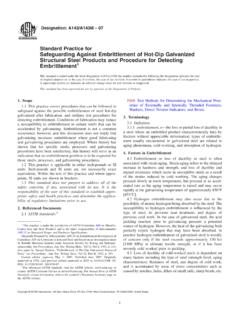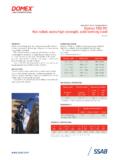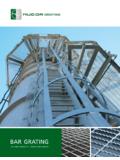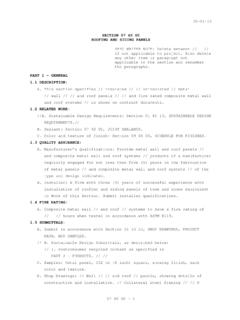Transcription of Zinc Coatings - Court Galvanizing Inc
1 zinc CoatingsMicrostructures of Various zinc CoatingsAmerican Galvanizers AssociationHot-Dip GalvanizedZinc PaintGalvanized SheetElectroplatedMetallized1 milZinc CoatingsContentsIntroduction .. 1 Production Processes for zinc Coatings .. 1 Batch Hot-Dip Galvanizing .. 1 Continuous Sheet Galvanizing .. 1 Electrogalvanizing .. 2 zinc Plating .. 3 Mechanical Plating .. 3 zinc Spraying (Metallizing) .. 3 zinc Painting .. 4 Characteristics of zinc Coatings .. 4 Batch Hot-Dip Galvanizing .. 4 Continuous Sheet Galvanizing .. 5 Electrogalvanizing .. 5 zinc Plating .. 6 Mechanical Plating .. 6 zinc Spraying (Metallizing) .. 6 zinc Painting .. 6 Selection of zinc Coatings .. 7 coating Thickness vs. coating Weight .. 7 Economic Considerations .. 8 Conclusion & Acknowledgements .. 8 American Galvanizers Association6881 S. Holly Circle, Suite 108 Centennial, CO 801121-800-468-7732720-554-0900 FAX 720-554-0909E-mail: Copyright 2006 American Galvanizers Association.
2 The material provided herein has been developed to provide accurate and authoritative information about after-fabrication hot- dip galvanized steel. This material provides general information only and is not intended as a substitute for competent professional examination and verifi cation as to suitability and applicability. The information provided herein is not intended as a representation or warranty on the part of the AGA. Anyone making use of this information assumes all liability arising from such Galvanizers Association 1 IntroductionZinc has a number of characteristics that make it a well-suited corrosion protective coating for iron and steel products in most environments. Th e excellent fi eld performance of zinc Coatings results from its ability to form dense, adherent corrosion product fi lms and a rate of corrosion considerably below that of ferrous materials (some 10 to 100 times slower depending upon the environment).
3 While a fresh zinc surface is quite reactive when exposed to the atmosphere, a thin fi lm of corrosion products develops rapidly, greatly reducing the rate of further corrosion. In addition to creating a barrier between steel and the environment, zinc also has the ability to cathodically protect the base metal. zinc , which is anodic to iron and steel, will preferentially corrode and protect the iron or steel against rusting when the coating is damaged (see Figure 1, below).Many diff erent types of zinc Coatings are commercially available, and each has unique characteristics. Th ese characteristics not only aff ect applicability but also the relative economics and expected service life. Th e method of processing, adhesion to the base metal, protection aff orded at corners, edges, and threads, hardness, coating density, and thickness can vary greatly among the diff erent is practical aid discusses each of the major types of zinc Coatings , applied by batch hot-dip Galvanizing , continuous sheet Galvanizing , electrogalvanizing, zinc plating, mechanical plating, zinc spraying, and zinc painting, to help specialists assess and select zinc Coatings for corrosion Processes for zinc CoatingsBatch Hot-Dip Galvanizing .
4 Th e batch hot-dip Galvanizing process, also known as general Galvanizing , produces a zinc coating on iron and steel products by immersion of the material in a bath of liquid zinc . Before the coating is applied, the steel is cleaned to remove all oils, greases, soils, mill scale, and rust. Th e cleaning cycle usually consists of a degreasing step, followed by acid pickling to remove scale and rust, and fl uxing, which inhibits oxidation of the steel before dipping in the molten ere are two diff erent fl uxing methods, dry and wet. Th e dry process is accomplished by pre-fl uxing in a zinc ammonium chloride solution. Th e wet process uses a molten fl ux blanket on the zinc bath surface (see Figure 2, next page).Hot- dip galvanized Coatings are used on a multitude of materials ranging in size from small parts such as nuts, bolts, and nails to very large structural shapes.
5 Th e size of available zinc baths and material handling restricts the size of steel that can be galvanized . Molten zinc baths 60 feet long and eight feet deep are common in North America. However, the maximum size that can be accommodated in the zinc bath is increased substantially, to near double bath length or depth by progressive dipping (immersing one portion of the product and then the other).Because the material is immersed in molten zinc , the zinc fl ows into recesses and other areas diffi cult to access, coating all areas of complex shapes thoroughly for corrosion Sheet Galvanizing . Th e continuous hot-dip coating process is a widely used method originally developed over fi fty years ago for Galvanizing of products such as steel sheet, strip, and wire. Th e molten coating is applied onto the surface of the steel in a continuous process.
6 Th e Figure 1: Cathodic Protection from ZincArrangement of Metals in Galvanic SeriesCathodic protections can occur when two metals are electrically one of these metals and alloys will theoretically corrode while offering protection to any other which is lower in the series, so long as both are electrically , in actual practice, zinc is by far the most effective in this ENDA nodic or less noble(ELECTRONEGATIVE)MagnesiumZincAlumi numSteelLeadTinNickelBrassBronzesCopperS tainless Steel (passive)SilverGoldPlatinumPROTECTED ENDC athodic or more noble(ELECTROPOSITIVE)Removal from Batch Galvanizing BathZinc Coatings2 American Galvanizers Associationsteel is passed as a continuous ribbon through a bath of molten zinc at speeds up to 600 feet per minute. Th e size of the steel sheet can range from to inches ( to ) thick, and up to 72 inches (1830mm) is continuous hot-dip coating process begins by cleaning the steel in a process unit that typically uses an alkaline liquid combined with brushing, rinsing, and drying.
7 Th en, the steel passes into the heating or annealing furnace to soften it and impart the desired strength and formability. In this annealing furnace, the steel is maintained under a reducing gas atmosphere, composed of hydrogen and nitrogen, to remove any oxide that may be on the steel surface. Th e exit end of the furnace is connected with a vacuum chamber, known as a snout, to the molten coating bath to prevent any air from re-oxidizing the heated steel product. In the bath, the steel product is sent around a submerged roll and reacts with the molten metal to create the bonded coating , and then removed in a vertical direction. Once the product is removed from the bath, high-pressure air is used to remove any excess molten zinc to create a closely controlled coating thickness. Th en the steel is cooled to allow the metal to solidify onto the steel surface, which is done before the steel contacts another roll to avoid transferring or damaging the e hot-dip process for sheet product is used today to make seven diff erent types of hot-dip coated products, including galvanized ( zinc ), galvannealed (90-92% zinc / 8-10% iron alloy), two alloys of zinc and aluminum (55% aluminum / 45% zinc alloy & 95% zinc / 5% aluminum alloy), two aluminum based alloys (100% aluminum, 89-95% aluminum / 5-11% silicon alloy), and the terne coating (85-97% lead / 3-15% tin alloy).
8 In 2004, there were approximately 85 hot-dip lines in North America, each of which could apply at least one of the seven Coatings listed Electrogalvanized Coatings are applied to steel sheet and strip by electrodeposition. Electrogalvanizing is a continuous operation where the steel sheet or strip is fed through suitable entry equipment, followed by a series of washes and rinses, and fi nally into the zinc plating e most common zinc electrolyte-anode arrangement uses lead-silver, or other insoluble anodes and electrolytes of zinc sulfates. Soluble anodes of pure Figure 2: Batch Hot-Dip Galvanizing ProcessesWet galvanizingPicklingCausticcleaningRinsin gRinsingFluxZinc bathCooling andinspectionDry galvanizingPicklingRinsingRinsingFluxsol utionCausticcleaningDryingZincbathCoolin g andinspectionAmerican Galvanizers Association 3zinc are also used. In this process, the steel sheet is the cathode.
9 Th e coating develops as zinc ions in the solution are electrically reduced to zinc metal and deposited on the cathode. Grain refi ners may be added to help produce a smooth, tight-knit zinc coating on the Plating. zinc plating is identical to electrogalvanizing in principle because both are electrodeposition processes. zinc plating is used for Coatings deposited on small parts such as fasteners, crank handles, springs and other hardware e zinc is supplied as an expendable electrode in a cyanide, alkaline non-cyanide, or acid chloride salt solution. Cyanide baths are the most operationally effi cient but can potentially create pollution and are alkaline or electrolytic cleaning, pickling to remove surface oxides, and rinsing, the parts are loaded into a barrel, rack, or drum and immersed in the plating solution. Various brightening agents may be added to the solution to add luster, but careful control is needed to ensure a quality product.
10 Post-plating treatments may be used to passivate the zinc surface as well as impart various translucent colors or to extend the life of the coating . Mechanical Plating. Small iron and steel parts may be coated by drum tumbling with a mixture of proprietary promoter chemicals, zinc powder, and glass beads. After cleaning the parts usually limited in size to about 8-9 inches (200-300mm) and weighing less than one pound ( kg) they are fl ash copper coated and loaded into a plating barrel. Th en the barrel is fi lled with chemicals, glass beads, and zinc powder and tumbled (see Figure 3, above). Th e tumbling action causes the beads to peen the zinc powder onto the part. Th ickness is regulated by the amount of zinc charged to the plating barrel and the duration of tumbling time. After coating , the parts are dried and packaged, or post-treated with a passivation fi lm, then dried and mechanically plated must be simple in design.







